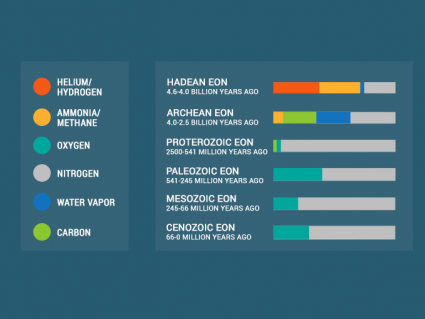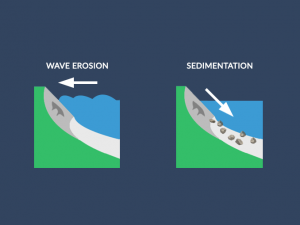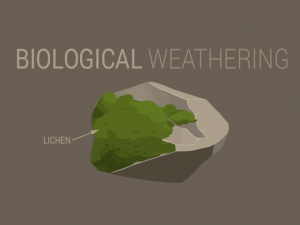What Are the 3 Types of Rocks?

Earth is covered with these 3 types of rocks are:
- Sedimentary rocks
- Metamorphic rocks
- Igneous rocks
Here’s how they are different from each other. And how they form. Find out more below.
1. Sedimentary Rocks
The key ingredient to sedimentary rocks is sediments. Sediments are just rocks that have been broken down by weathering. Sedimentary rocks form from two key processes:
- First, compaction squeezes material together.
- Second, cementing glues the squeezed material together.
If you start with a big boulder and speed up time 10,000 years ahead, it would erode away into tiny, little sediments. These weathered sediments are the ingredients that cement into sedimentary rocks like sandstone, limestone, and shale.

If you look at the Earth’s crust, only 5% of it is composed of sedimentary rocks. But 75% of the land surface contains sedimentary rocks. So, it’s rare to find sedimentary rocks at the ocean’s bottom.
Clastic Sedimentary Rocks
If you take the term “Clast”, all it means is just sediments. So clastic rocks form from compacted sediments. Also, clastic rocks are inorganic. In other words, they don’t contain any living material.

There are different types of clastic rocks. For example, we can branch off into conglomerate, breccia, sandstone, siltstone, and shalestone rocks.
Organic (Crystalline) Sedimentary Rocks
Organic and crystalline rocks don’t necessarily form from compacted sediments. Instead, it involves some type of chemical process.
2. Metamorphic Rocks
The process of formation of metamorphic rocks starts with existing rocks. Then, they undergo some sort of change due to immense heat or pressure.
For example, a rock made of sand is “metamorphosed” into another type of rock when it comes in contact with intense heat. They can’t melt because then it would be heading for the igneous state.

When it’s metamorphosed, it’s soft and pliable like cookie dough. This intense pressure for metamorphic rocks comes from inside Earth. Earth’s major mountain chains contain metamorphic rocks because it’s at plate tectonics boundaries where this intense pressure exists.
Contact Metamorphic Rocks
Contact metamorphism involves existing rocks coming into contact with intense heat. This heat generally comes from lava or magma.
When layers of rocks come in close contact with magma, they can undergo metamorphosis into another type of rock.
And this usually happens because magma plumes move to the upper part of the crust.
So, contact metamorphism involves the surrounding rock being burned from intense heat. Heat ranges from around 300° to over 800°C.
Regional Metamorphic Rocks
Instead of heat, the key catalyst for regional metamorphism is mostly pressure. For example, when there are two convergent plates pushing together, there will be immense pressure at the fault in between.
It’s at this fault in the middle where rocks will undergo regional metamorphism. For example, gneiss is a metamorphic that forms due to intense pressure. Gneiss is known for having bands where all the layers are squeezed.
Then, if you are even more pressure to gneiss, of would melt into igneous rocks. Gneiss is usually the extent of metamorphism that we see.
3. Igneous Rocks
Igneous rocks form after cooling and solidifying from magma or lava. So when molten rock cools, they turn solid and become igneous rock. First, you have to understand the difference between lava and magma. And it’s all about location.
For a volcano when it’s deep inside the Earth, it’s magma. Once it erupts, it’s lava. Then, it cools and solidifies. But it matters where it cools and solidifies.

Because of the immense pressure that igneous rocks undergo, it erases any fossil evidence. Likewise, this is true for the immense heat from metamorphic rocks. So if you see a rock with a fossil, you can automatically assume that it is a sedimentary rock.
There are two types of igneous rocks. Based on texture and composition, we can classify them into two categories:
- Intrusive (or plutonic) rocks form inside the Earth from magma.
- Extrusive rocks cool and solidify on the surface.
Intrusive (Plutonic) Igneous Rocks
For intrusive (or plutonic) rocks, magma is hot inside the Earth so it cools slowly. When it cools, minerals form slowly.
Intrusive rocks offer a fascinating glimpse into the slow and complex processes that shape the Earth’s interior. These rocks originate from molten magma that resides deep within the Earth’s crust and mantle.
So crystals grow very large for intrusive igneous rocks. For example, gabbro, granite, and pegmatite are intrusive rocks.
Extrusive Igneous Rocks
Extrusive rocks, in contrast to their intrusive counterparts, undergo a rapid cooling process as they form on or near the Earth’s surface.
Because they cool quickly, the crystals are smaller. Some types of extrusive igneous rocks can even have pockets of air bubbles inside them.
As the rock solidifies quickly, these gases become trapped in the form of tiny bubbles or vesicles. For example, extrusive rocks include basalt, andesite, and obsidian.
What Are the 3 Types of Rocks?
You see, rocks are the foundation of any ecosystem. They serve as an anchor for plants and animals alike. They also provide a place for water to collect and then evaporate back into the atmosphere, cool the earth, and make plants grow.
There are three types of rocks that dominate land: sedimentary rock, metamorphic rock, and igneous rock. Each type is unique because they come in an endless variety of shapes, sizes, colors, and textures.
If you have any questions or comments, please use the comment form below to get in touch with us.















Perfect speed of info for me.
I’d also like to know their chemical compositions by looking at them, and where they are found.
Like how does malachite form? Is magma very heterogeneous?
And where are rare earth metals typically?
Interesting stuff.
Yes. Thank you.
meh
The article is amazing in that the notes are summarized but very educative and easy to understand ❤️🤝
This article was pretty good